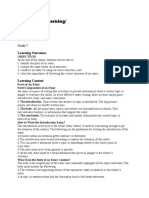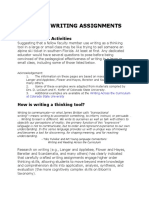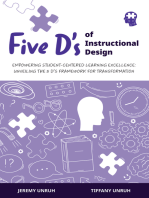LESSON TITLE: - Brainstorming Ideas For TOEFL Independent Writing - Lesson #: - 1
LESSON TITLE: - Brainstorming Ideas For TOEFL Independent Writing - Lesson #: - 1
Uploaded by
api-253824395Copyright:
Available Formats
LESSON TITLE: - Brainstorming Ideas For TOEFL Independent Writing - Lesson #: - 1
LESSON TITLE: - Brainstorming Ideas For TOEFL Independent Writing - Lesson #: - 1
Uploaded by
api-253824395Original Title
Copyright
Available Formats
Share this document
Did you find this document useful?
Is this content inappropriate?
Copyright:
Available Formats
LESSON TITLE: - Brainstorming Ideas For TOEFL Independent Writing - Lesson #: - 1
LESSON TITLE: - Brainstorming Ideas For TOEFL Independent Writing - Lesson #: - 1
Uploaded by
api-253824395Copyright:
Available Formats
LESSON TITLE: _Brainstorming Ideas for TOEFL Independent Writing_
Lesson #: _1_
TEACHER NAME: __Wenwei Liu____ DATE:____4
th
March, 2014____
Attach any handouts or materials required for this lesson.
Preparation/Planning
ESL Course: TOEFL
Writing
Level
Beginning
Intermediate
Advanced
Multilevel
Topic/Theme:
Brainstorming ideas for
TOEFL (Test of English as a
Foreign Language)
Independent Writing
Objectives
Listening NA
Speaking NA
Reading NA
Writing The development of ideas in TOEFL independent writing will be
supported via brainstorming.
Bridging
What background knowledge
do the students already have?
1. The requirements of independent writing in TOEFL:
Suggested Time: 30 minutes
Response Length: 300+ words
Description: Present a personal opinion or describe an
experience, including details and examples
2. Sample Outline:
Introduction:
Topic
Thesis statement
Body:
Key point 1
Topic sentence
Reasons, examples, and details
Key point 2
Topic sentence
Reasons, examples, and details
Key point 3
Topic sentence
Reasons, examples, and details
Conclusion:
Restatement of thesis and concluding sentence
What will you do to activate
or link students prior
knowledge or experience to
upcoming content?
I will review the requirements of independent writing with students as
part of the initial instructional component before giving them the
writing prompts: Which one do you prefer? One or two close friends or
a large number of casual acquaintances. In addition, I will go over the
sample outline with the students, as the students will be required to
write their own essays utilizing this structure.
Engagement with New Material
What will you do to engage
students in the active learning
of the new material?
In the I Do activity, I will brainstorm ideas on a given TOEFL
independent prompt together with the students as a whole class. The
prompt is Do you agree or disagree with the following statement? It is
better to have one or two close friends than to have a large number of
casual acquaintances. I will ask students come up with their opinions.
From the prompt, they need to present whether they agree or disagree
with the statement. Using the graphic organizer (See Appendix A), I
plan to write their thesis in the center of the whiteboard. Then students
will be facilitated to associate whatever related to the prompt with their
opinions and presented the key points. The questions I am going to ask
for promoting their brainstorming are: Do you have one or two close
friends? That what did they do for you makes you prefer one or two
close friends to lots of casual acquaintances? How did they help you?
Can you give me an example? I will write down students explanations
and examples from which students will share their ideas with the class.
Since the students did not have ideas in supporting their thesis then, I
will model for them how I develop my ideas from presenting the key
point with general explanation, supported by examples. And I will
write down some brief sentences on the board. After I scaffold for the
students, they are going to be required to developed ideas from key
points, explanations to examples as a whole class.
What will you do to ensure
that all students are engaged?
With regard to the prompt, students may have more interest in
exploring because these topics are related to their daily life and
experiences. Students will be asked questions in order to check for
comprehension as I circulate around the classroom in the group
activity. I will also pay attention to students who may be off-task to
see if there is any reason for this. Perhaps, they are not clear about the
directions or are struggling with coming up with ideas.
Application
What opportunities will you
provide students to practice
and apply their
knowledge/skill to meet the
objectives for this lesson? To
apply to other contexts?
In the You Do activity, students will be required to write an essay
individually by brainstorming ideas and elaborating on supporting
details on another prompt based on the scaffoldings provided in the I
Do and We Do activities: Do you agree or disagree with the following
statement: it is better to spend money on pleasant things such as
vacations than to save money for the future.
Assessment
How will you assess their
learning of the objectives?
I will assess students learning based on the writing assignment from
the You Do activity. I plan to focus on the development of ideas by
using TOEFL Independent Writing Rubric (See Appendix B).
Previously, they did not have enough ideas and examples in their
writing. After this class, I want to investigate whether they will be able
to generate more ideas and examples in their writing.
Closing
How will you help students I will review brainstorming with the students using examples we
recap the learning and link it
back to the original purpose of
the lesson?
discussed in class. it will help students deepen their understanding of
brainstorming. In addition, I will share the sample outline for TOEFL
independent writing, which will support their understanding of the
format of any writing they do.
Technology
If applicable for your context
and your lesson, how will you
meaningfully integrate
technology into your lesson?
I will use PowerPoint to introduce this classs agenda and to show
students the Sample Outline in TOEFL independent writing.
Reflection
What went well? How do you
know?
I think generally the class went well based on the feedback from my
mentor teacher and the performance of the students in class. I was not
appearing nervous and did a good job with timing, students were never
rushed.
What didnt go as planned? In the group activity, some groups finished the task fast but other
groups were lagging behind.
What contingency plan did
you employ?
There were two students being late for the class. I just continued my
lesson moving to the next activity for group work. I walked around and
generally explained what we discussed in the whole class to the
students who were late for class and helped them scaffold in the group
work.
What would you do
differently next time?
Since some groups completed the task quickly and other groups did
not, I would assign those groups who finished fast more practice.
Did your students meet the
purpose and objectives for this
lesson? How do you know?
Most of the students meet the purpose while there are still some other
students who may not. Based on the final writing samples writing in
class, most of them developed more ideas and supporting details
compared with previous writing samples. However, some other
students still had difficulties in generating ideas. They will need
another lesson to practice.
What do your students need
next? How do you know?
What my students need next is more time on explanations of how to
brainstorm with more practice of different topics. According to the
students feedback forms, some would like more practice to reinforce
the strategies of brainstorming since they thought brainstorm and
graphic organizers help them generating ideas and details in TOEFL
independent writing.
What did you learn about your
glows and grows as a teacher?
What can you do to work on
your areas needing growth?
I found I did not check all the students understanding of what I taught
in the whole-class activity and I just heard the voice from the students
who actively answered my questions. I should pay more attention to
these quiet students. This will be my next observation objective.
Appendix A
Graphic Organizer
[Main Point 1] _____________________________
[Explanation]______________________________
[General and Specific Examples]________________
[Summary]_______________________
[Main Point 2] _______________ [Main Point 3] ____________________
[Explanation]____________________ [Explanation]______________________
[General and Specific Examples]__________________
[General and Specific Examples]_______________
[Summary]____________________________________
[Summary]____________________________
Appendix B
You might also like
- Lesson Plan & Implementation: Level 3 Video Reflection and AnalysisDocument5 pagesLesson Plan & Implementation: Level 3 Video Reflection and Analysisapi-498747980No ratings yet
- Artisan Teacher OverviewDocument5 pagesArtisan Teacher OverviewnjirbyNo ratings yet
- Thesis LessonDocument8 pagesThesis Lessonaouetoiig100% (2)
- fs10 PrintDocument13 pagesfs10 PrintNix AmrNo ratings yet
- Week2 Lesson15Research ProjectDocument5 pagesWeek2 Lesson15Research ProjectТеодора ВласеваNo ratings yet
- Ela Edtpa LessonDocument5 pagesEla Edtpa Lessonapi-313445058No ratings yet
- Examples of Statements and QuestionsDocument4 pagesExamples of Statements and QuestionsawanbioscienceNo ratings yet
- Learning Segement - Ela 1Document10 pagesLearning Segement - Ela 1api-254944388No ratings yet
- Comp Exam GuideDocument6 pagesComp Exam Guidehasmin_sescarNo ratings yet
- Overview: Module 4: Main Aim Subsidiary Aims Personal AimsDocument28 pagesOverview: Module 4: Main Aim Subsidiary Aims Personal AimsIslam TahaNo ratings yet
- Activities To Teach Thesis StatementsDocument7 pagesActivities To Teach Thesis StatementsBuyAPaperOnlineUK100% (2)
- 1 StobDocument4 pages1 Stobapi-257228749No ratings yet
- Writing Descriptive Paragraphs: Simple and Complex Sentences Practice Writing Complex Sentences Descriptive AdjectivesDocument14 pagesWriting Descriptive Paragraphs: Simple and Complex Sentences Practice Writing Complex Sentences Descriptive AdjectivesJason Franklin100% (1)
- Inquiry 2 Part ADocument10 pagesInquiry 2 Part Aapi-290860053No ratings yet
- An Action Research ExampleDocument6 pagesAn Action Research ExamplevitavituNo ratings yet
- Option 2: Insiders - Instructional Design For A Real StudentDocument3 pagesOption 2: Insiders - Instructional Design For A Real StudentsherrymiNo ratings yet
- Educ 250-Teaching Philosophy Assignment-Group Project 1Document3 pagesEduc 250-Teaching Philosophy Assignment-Group Project 1api-325337036No ratings yet
- Detailed Lesson Preparation Guide: Elementary EducationDocument3 pagesDetailed Lesson Preparation Guide: Elementary Educationapi-355728225No ratings yet
- How-To Lesson PlanDocument3 pagesHow-To Lesson Planapi-276590409No ratings yet
- First Lesson Graphic OrganizerDocument5 pagesFirst Lesson Graphic Organizerapi-450830120No ratings yet
- Maculada, Jodi Marie Beed 3-cDocument7 pagesMaculada, Jodi Marie Beed 3-cMa Lourdes Abada MaculadaNo ratings yet
- 450 Lesson 2Document7 pages450 Lesson 2api-309613026No ratings yet
- Lesson Plan TemplateDocument5 pagesLesson Plan Templateapi-298026665No ratings yet
- Intro To Delta PDADocument8 pagesIntro To Delta PDAbarrybearer100% (3)
- Strategy ToolkitDocument11 pagesStrategy Toolkitapi-317116409No ratings yet
- Reflective Lesson Plan (Context Clues)Document6 pagesReflective Lesson Plan (Context Clues)rpaige14No ratings yet
- Learning Segment-Ela 3Document10 pagesLearning Segment-Ela 3api-254944388No ratings yet
- Recess Lesson PlanDocument8 pagesRecess Lesson Planapi-425637153No ratings yet
- Reflective Lesson Plan Model Rubric - 450 - Revised 2013Document7 pagesReflective Lesson Plan Model Rubric - 450 - Revised 2013dburns1No ratings yet
- Option 2: Insiders - Instructional Design For A Real StudentDocument3 pagesOption 2: Insiders - Instructional Design For A Real StudentsherrymiNo ratings yet
- Teacher Behavior Ed IsDocument8 pagesTeacher Behavior Ed IsWidya Kristina ManaluNo ratings yet
- Deandra Sullivan Miniunit Mno TemplateDocument37 pagesDeandra Sullivan Miniunit Mno Templateapi-297184874No ratings yet
- What Is PBLDocument6 pagesWhat Is PBLaspetgregNo ratings yet
- Danielson Framework Lesson Plan Template: Result of The Lesson? (Component 1C)Document5 pagesDanielson Framework Lesson Plan Template: Result of The Lesson? (Component 1C)api-242556681No ratings yet
- Living Forever Lesson PlanDocument6 pagesLiving Forever Lesson Planapi-425637153No ratings yet
- Design Exercise Class 3Document4 pagesDesign Exercise Class 3Ilene Dawn AlexanderNo ratings yet
- Assignment 1 - Study Skills - Develop Personal Learning SkillsDocument4 pagesAssignment 1 - Study Skills - Develop Personal Learning SkillsfuturepetrcechNo ratings yet
- Peer Review Lesson PlanDocument5 pagesPeer Review Lesson Planapi-269729950No ratings yet
- Project 4 Lesson Task 1Document11 pagesProject 4 Lesson Task 1api-547286871No ratings yet
- Effective Writing Assignments: Write To Learn ActivitiesDocument11 pagesEffective Writing Assignments: Write To Learn Activitiesashok kumarNo ratings yet
- ESL Practicum Lesson PlanDocument5 pagesESL Practicum Lesson Planapi-404665962No ratings yet
- LP Commentary 1 InterviewsDocument2 pagesLP Commentary 1 Interviewsapi-249483736No ratings yet
- Elln Assignment Lesson 1 16Document20 pagesElln Assignment Lesson 1 16Venna Mae Jagonio100% (1)
- ELT Course ICPNADocument56 pagesELT Course ICPNAmaría fernandaNo ratings yet
- Supervisor Lesson Plan - TornadoesDocument5 pagesSupervisor Lesson Plan - Tornadoesapi-247277013No ratings yet
- Reflective EssayDocument4 pagesReflective EssayShare Linh TinhNo ratings yet
- Peer Teaching ObservationDocument4 pagesPeer Teaching ObservationharrindlNo ratings yet
- Reflective Lesson Plan (Idioms)Document7 pagesReflective Lesson Plan (Idioms)rpaige14No ratings yet
- Lord of The Flies EssayDocument6 pagesLord of The Flies Essayapi-257595875No ratings yet
- Expository Lesson PlanDocument6 pagesExpository Lesson Planapi-265180782100% (2)
- Six Steps Lesson PlanDocument3 pagesSix Steps Lesson PlanElinoreDarziNo ratings yet
- Learning Segment-Ela 2Document10 pagesLearning Segment-Ela 2api-254944388No ratings yet
- Approaches and Methods in Language Teaching, Fall 2019: Report On Interaction With A Second Language LearnerDocument4 pagesApproaches and Methods in Language Teaching, Fall 2019: Report On Interaction With A Second Language LearnerIndex FotokopirnicaNo ratings yet
- Reading-Writing Lesson PlanDocument2 pagesReading-Writing Lesson Planapi-300462236No ratings yet
- HygfyhjhkjjhukjDocument10 pagesHygfyhjhkjjhukjMerry Ann TamalonNo ratings yet
- Presentation SkillsDocument9 pagesPresentation SkillsIndah ChristinNo ratings yet
- Strategies For Effective Lesson PlanningDocument6 pagesStrategies For Effective Lesson PlanningDromor Tackie-YaoboiNo ratings yet
- Kid Writting LessonDocument5 pagesKid Writting Lessonapi-707478422No ratings yet
- PDC2 Handout - AssessmentDocument3 pagesPDC2 Handout - AssessmentAras'ın MaceralarıNo ratings yet
- Candicebrown MidcourseDocument6 pagesCandicebrown Midcourseapi-325715378No ratings yet
- Five D’s of Instructional Design: Empowering Student-Centered Learning Excellence: Unveiling the 5 D's Framework for TransformationFrom EverandFive D’s of Instructional Design: Empowering Student-Centered Learning Excellence: Unveiling the 5 D's Framework for TransformationNo ratings yet
- Appendix eDocument1 pageAppendix eapi-253824395No ratings yet
- Independent Writing Rubrics 2008Document1 pageIndependent Writing Rubrics 2008api-253824395No ratings yet
- Independent Writing Rubrics 2008Document1 pageIndependent Writing Rubrics 2008api-253824395No ratings yet
- Appendix eDocument1 pageAppendix eapi-253824395No ratings yet
- Appendix BDocument1 pageAppendix Bapi-253824395No ratings yet
- Yash Sault SopDocument4 pagesYash Sault SopEminence SOP WritersNo ratings yet
- Luo Qianlin: Personal Personal Details Details Educational Educational Background BackgroundDocument2 pagesLuo Qianlin: Personal Personal Details Details Educational Educational Background Backgroundapi-560144507No ratings yet
- APA Formatting & StyleDocument39 pagesAPA Formatting & StyleEdward GanNo ratings yet
- Ndebele Cala SampleDocument26 pagesNdebele Cala Sampleaddy0% (1)
- Ayo Siwes ReportDocument22 pagesAyo Siwes Reportolowoniyiisrael2020No ratings yet
- Social PresenceDocument14 pagesSocial PresenceJessica Nicole GardinerNo ratings yet
- Sample Resume Format - Summers 2013Document2 pagesSample Resume Format - Summers 2013siddhant sethiaNo ratings yet
- Design of Drainage System in Patamaba Wawa Angono RizalDocument30 pagesDesign of Drainage System in Patamaba Wawa Angono RizalColeen IrisNo ratings yet
- Training Design For inDocument14 pagesTraining Design For inFhikery ArdienteNo ratings yet
- PHD7010 Assignment - Shahidan - 202009060023Document14 pagesPHD7010 Assignment - Shahidan - 202009060023shahidanNo ratings yet
- Sas17 Psy 002Document12 pagesSas17 Psy 002Ritchell AccountsNo ratings yet
- Typology of Learning DisabilitiesDocument29 pagesTypology of Learning DisabilitiesFloieh Quindara100% (1)
- Module 2 - PERCEPTION, LEARNING AND MEMORYDocument4 pagesModule 2 - PERCEPTION, LEARNING AND MEMORYSha ShaNo ratings yet
- Đặng Hoàng Ngân Thích Ứng Thang HPDocument13 pagesĐặng Hoàng Ngân Thích Ứng Thang HPHoài Diệu VõNo ratings yet
- Ang Organisasyon NG SimbahanDocument5 pagesAng Organisasyon NG SimbahanrhonamaeNo ratings yet
- Tarea Week 4-5-6 10th GradeDocument19 pagesTarea Week 4-5-6 10th GradeKelvin CanoNo ratings yet
- Public Financing For UHC OctNov LoP FINALDocument14 pagesPublic Financing For UHC OctNov LoP FINALsyaiful rinantoNo ratings yet
- Ok - Parenting Style As Context - Darling, 1993Document10 pagesOk - Parenting Style As Context - Darling, 1993Paola Vargas BarbosaNo ratings yet
- Part 3 - Vstep - SpeakingDocument11 pagesPart 3 - Vstep - SpeakingNgoc ThanhNo ratings yet
- Linking Words For IELTS Speaking - Word List & Tips PDFDocument22 pagesLinking Words For IELTS Speaking - Word List & Tips PDFSanjay SahooNo ratings yet
- Roman TunnelsDocument7 pagesRoman TunnelsElf MeralNo ratings yet
- Action Research FormatDocument2 pagesAction Research FormatRhylyahnaraRhon Palla Peralta75% (4)
- PhonicDocument41 pagesPhonicAnusuya RamasamyNo ratings yet
- 2nd Summative Test 3rd QuarterDocument3 pages2nd Summative Test 3rd QuarterEmelie HernandezNo ratings yet
- Pengantar Rock PhysicsDocument13 pagesPengantar Rock PhysicsAwang SoedrajatNo ratings yet
- Narra, Jennifer A. DLLDocument3 pagesNarra, Jennifer A. DLLJennifer NarraNo ratings yet
- 1.1: Displaying and Describing Categorical Data: Number of Class Periods: Essential QuestionsDocument4 pages1.1: Displaying and Describing Categorical Data: Number of Class Periods: Essential Questionsapi-261949370No ratings yet
- Covid-19 Pneumonia Classification Using Deep Learning TechniqueDocument20 pagesCovid-19 Pneumonia Classification Using Deep Learning TechniqueJilly Arasu100% (1)
- Guidelines For Becoming A Remote CentreDocument5 pagesGuidelines For Becoming A Remote CentreManoranjan RajguruNo ratings yet





























































































